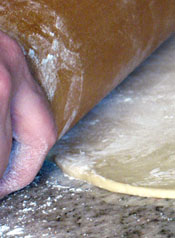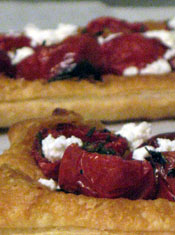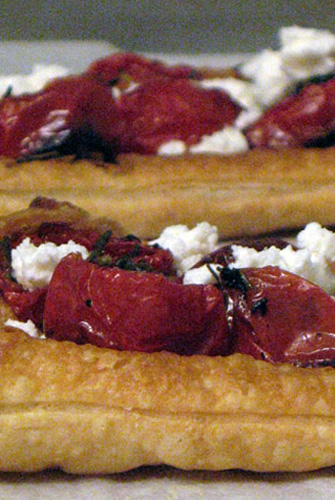Ingredients 101: Frozen Puff Pastry
I love to both cook and bake. I'm not very practiced with cakes, but I'm proud of my pies, tarts, cobblers, teacakes, crackers and cookies and I love the assembly and process that they require. However, the fact remains that I do cook more than I bake, but this frankly has more to do with calorie management than how I want to spend my kitchen time. I suppose I could bake and just give the stuff away, but I have neither the time nor food budget to bake for sheer sport and I definitely don't have the willpower to resist my own brownies.
In the world of professional cooking, pastry chefs have their own status, and in restaurants, their own kitchens. When I went to culinary school nearly all of our classes were spent on "cooking" and not "baking." Only one class taught pastry making but that was tilted toward main courses, like quiche, and not dessert. Since I wanted to know more about baking I've taken some extra classes, including one that put us through the daunting paces of making our own puff pastry.
Mille-feuille, French for "a thousand leaves," is also the name for a pastry with delicate, rich and crispy paper-thin leaves that can shatter with a bite. It's achieved with a dough called pâte feuilletée that is made by wrapping a dough around a block of butter that is then rolled, folded, chilled, and then again rolled and folded back upon itself, six or eight times, chilling and resting between each step. The result is a packet of dough that in fact is made up of many layers of dough and butter. When baked at a high temperature, usually 375° F to 400° F, the layers of butter melt and its moisture creates steam, lifting the sandwiched layers of dough into a crispy puff.
A Great Invention: Frozen Puff Pastry
Making your own puff pastry isn't difficult but it is both time-consuming and a meticulous process. Is it worth it? As with most things, home-made puff pastry is almost always better than store-bought, plus you can control the quality of the butter, puff pastry's defining ingredient. But because puff pastry is usually not the centerpiece but a companion to other foods -- whipped cream, or cheese, or caramelized onions, or fruit -- we have the option to use one of the best store-bought foods ever invented: frozen puff pastry.
There are two leading producers of frozen puff pastry: Pepperidge Farm and Dufour. A 14 oz. box of Dufour (a New York City company) contains two large sheets of dough, costs about $10, and the pastry dough is made with butter. You can find Dufour at many markets, including Whole Foods and Fairway. Pepperidge Farms is easier to find in grocery stores and a 17.5 oz. box with two sheets costs about half of what Dufour does, but Pepperidge Farm's is made with vegetable shortening and not butter.
Trader Joe's also sells frozen puff pastry dough, sold only at their stores. Theirs is made with butter and costs about $5 for a one-pound box with two sheets. All three brands -- Dufour, Pepperidge Farm, and Trader Joe's, have excellent flavor and are easy to work with.
Here are the three most important things to know about frozen puff pastry dough:
- If you think you can't bake and are intimidated by the idea of making dishes from puff pastry because it seems so refined and complex, think again. Working with frozen puff pastry dough is as easy as opening one of those cylinders of refrigerated biscuits or cinnamon rolls. (But it tastes much, much better.)
- Frozen puff pastry is nothing like frozen pie dough. It's much better. When baked, every brand of frozen puff pastry dough actually tastes terrific and has a beautiful texture. Frozen pie dough has little resemblance to homemade. So it is not a concession in flavor or aesthetics to use frozen puff pastry dough.
- You don't need fancy tools to be a successful puff pastry baker. A cool, clean surface (a small kitchen counter is perfect), a little all-purpose flour, and a rolling pin and you'll be a master.
What Can You do With Frozen Puff Pastry?
Even if you're not a confident baker, a sheet of the dough can be defrosted, cut into circles or squares, baked in 10 minutes into puffy pieces, let to cool and used as the top and bottom of a layer of sweetened whipped cream and fresh berries -- you'll be happier than if you bought Napoleons at Payard Patisserie.
For a savory tart, cut the sheet of dough into two long rectangles and bake them with a topping of tomatoes or roasted vegetables and a sprinkle of grated cheese. Wrap a square of the raw dough around a circle of Brie and bake until the pastry is crispy and the cheese is runny. Cut a circle of the dough, bake it crisp in ten minutes and use it as the cover for a chicken potpie made with a leftover roasted chicken. Cut little triangles of dough, place a little cluster of chocolate chips in the center, and fold into a packet and bake to make your own pain au chocolat. Or you can make the easiest hors d'oeuvres by cutting the dough into little strips, dusting them with a sprinkle of grated cheese and bake. They take less than a half-hour to make and your dinner guests will be both impressed and happy.
If you keep a box of puff pastry in your freezer, the dough can defrost left overnight in your refrigerator or in a couple of hours on your counter. If you have last minute guests for dinner or cocktails, frozen puff pastry can be a way to make "home-made" treats for not a lot of money or time. Pick up a pint of sorbet on the way home from work and make almost-instant cookies by baking pieces of dough that have been sprinkled with sugar. Substitute grated cheese and grains of sea salt for the sugar and serve with a glass of wine. Your apartment will smell divine and your guests will love the buttery taste.
Puff, by Martha Holmberg
If you're interested in developing a repertoire of interesting dishes made with puff pastry dough and getting lessons in how to work with the dough, you should consider a book by Martha Holmberg called Puff (Chronicle Books, $19.95, paperback, color photographs). Its 144 pages include extremely helpful tips about working with puff pastry -- whether homemade or frozen. And she has excellent and accessible instructions for making your own pastry dough -- both the classic pâte feuilletée plus a less labor-intensive version called rough puff pastry or demi-feuilletée, easier than the traditional method but authentically your own, and not store bought.
Whether you make your own dough from scratch or buy it frozen at the supermarket, Ms. Holmberg has 50 recipes that put puff pastry to delicious use in every stage of a meal: appetizers and snacks, first courses and main dishes, and desserts, cookies and other sweets.
Some of Ms. Holmberg's tips were revelations for me. First, she showcases how sturdy and adaptable this pastry dough is. You may think that because it produces a delicate result that handling the raw dough is a challenge. Not so. Here's another bit of information that I loved: you can defrost the dough, use part of it, and then re-freeze the leftovers for another time. I loved learning this because if I've paid $5 for a package and use most, but not all of it for a tart or hors d'oeuvres, now I can save the scraps and use them another time, even if only to bake little fancy croutons to serve with soup. Waste is always regrettable but to toss away puff pastry is a terrible thing.
We've been given permission to share a couple of Martha Holmberg's recipes with you and we've chosen a savory Provencal Pizza and small, sweet Apricot and Gingersnap Rustic Tarts knowing that apricots are the first stone fruit due to arrive this spring.
I think that frozen puff pastry dough is one of the great inventions of the last century because it eliminates a barrier to cooking foods that we might otherwise think are outside our skill or our schedules. And does so with little compromise. It's a perfect city cook ingredient.




